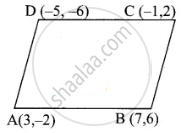Advertisements
Advertisements
प्रश्न
Verify that the following points taken in order to form the vertices of a rhombus
A(3, −2), B(7, 6), C(−1, 2) and D(−5, −6)
उत्तर

Distance =
AB =
=
=
=
BC =
=
=
=
CD =
=
=
=
AD =
=
=
=
AB = BC = CD = AD =
All the four sides are equal.
∴ ABCD is a rhombus.
APPEARS IN
संबंधित प्रश्न
If the co-ordinate of A is x and that of B is y, find d(A, B).
x = -3, y = -6
Find d(A, B), if co-ordinates of A and B are -2 and 5 respectively.
On a number line, co-ordinates of P, Q, R are 3, -5 and 6 respectively. State with reason whether the following statement is true or false.
d(P, Q) + d(Q, R) = d(P, R)
Find the distance between the following pair of points
(3, −9) and (−2, 3)
Show that the following points taken in order to form an equilateral triangle
Show that the following points taken in order to form the vertices of a parallelogram
A(−7, −3), B(5, 10), C(15, 8) and D(3, −5)
Verify that the following points taken in order to form the vertices of a rhombus
A(1, 1), B(2, 1), C(2, 2) and D(1, 2)
The abscissa of a point A is equal to its ordinate, and its distance from the point B(1, 3) is 10 units, What are the coordinates of A?
Show that the point (11, 2) is the centre of the circle passing through the points (1, 2), (3, −4) and (5, −6)
Find the distance with the help of the number line given below.

d(P, C)
